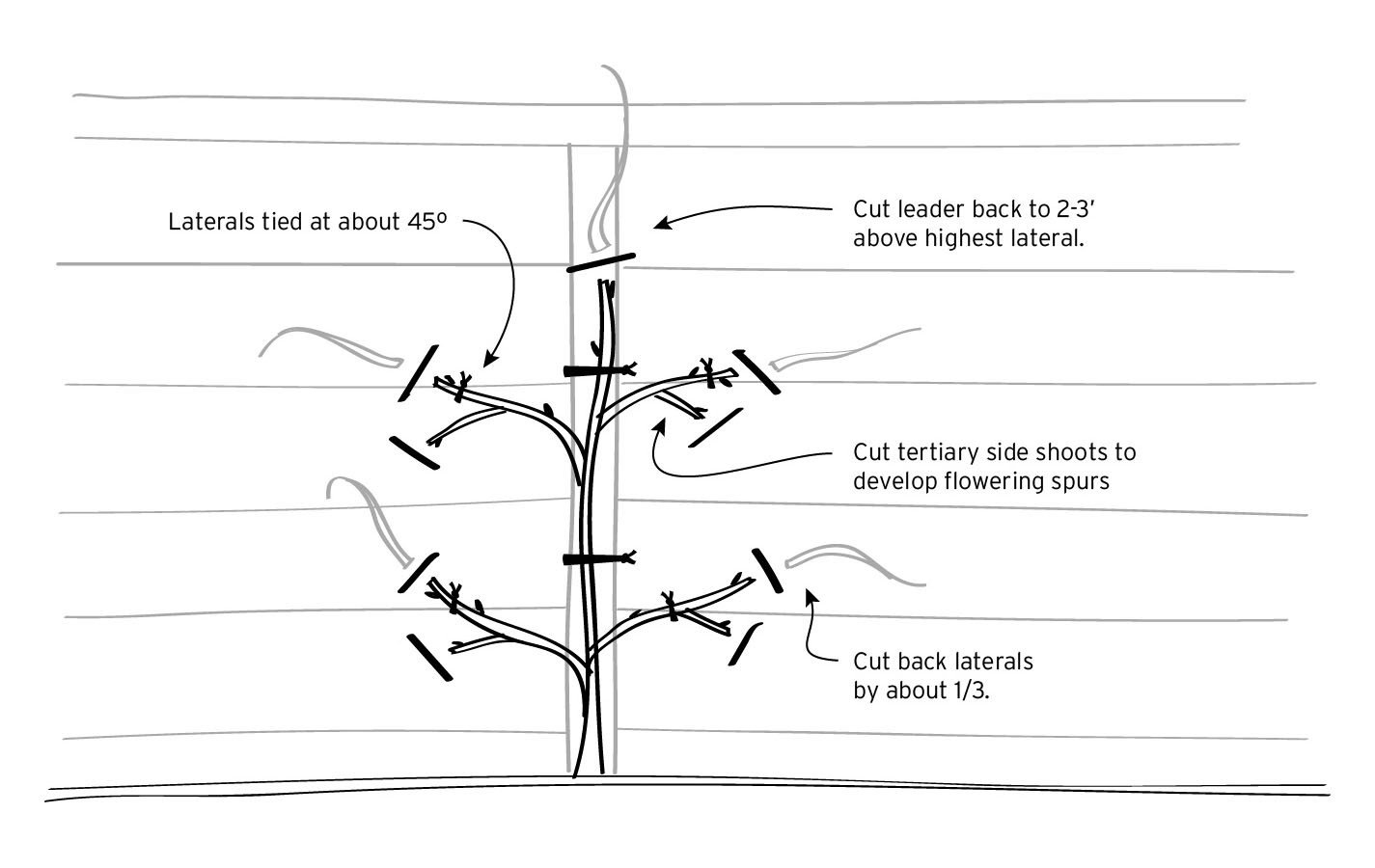Wisteria Pruning
Pruning techniques
Maintenance pruning should be undertaken twice a year, once in late summer (to five buds from the main network) and again in the winter (to 2 buds from the main network).
Cut back whippy green shoots of the current year’s growth to five or six leaves after flowering in July or August. Summer pruning should also aim to remove leaves impeding flowers and to improve air circulation within the plant.
Overview
Summer- Whippy growth to be cut 5 buds from the main mass of the plant (with your hand reach in and follow an extension growth back into the bushy mass of the wisteria then pull outwards along the whip-like stem counting each bud you pass, when five have been passed make your cut).
Winter- cut shoots back to just 3 buds from the main network.
Training- fresher and less rigid shoots require tying and where an espallier form is in development do so at 45 degree angles from the main stem.
winter pruning (2 buds from main branch network)
Summer prune
To maximise the success of the Wisteria flowering next year, that seasons growth should be cut back to within 15-30cm of the main network* in late summer to keep the plant within the intended bounds whilst diverting energy towards the flowering buds instead of the secondary extension growth.
*(unless extension is required to fill in vacant spaces on the wall or to extend existing laterals or to replace damaged branches)
Winter prune
In winter, the main stem should be topped by chopping the tip roughly 75cm above the topmost lateral sideshoot. The 45 degree sideshoots should be carefully lowered to horizontal if possible and these should be pruned back to 1/3 of its length. This should be continued each year to develop the intended network.
Training and establishing a Wisteria into an espalier form
Most commonly Wisteria’s are trained up walls in an espalier form (see diagram). This can be achieved through encouraging horizontal growth through training by tying the main stems horizontally to encourage flowering. To continue growth and maximise coverage, the strongest sideshoots growing off the main stem must be identified one on each side and these should be tied at 45 degree angles from the main stem when establishing a young espallier Wisteria.
General care
Soil conditions
Despite regular pruning Wisteria can still suffer with insufficient blooms due to a number of reasons. Poor soil should be the first factor to rule out. This is influenced by the following conditions:
Water
Wisteria are fairly drough tolerant but will need watering well through during dry spells. In particularly dry conditions it may be worth mulching the surrounding soil surface following watering to reduce moisture through evaporation.
Microclimate
Wisteria require plenty of sun to flower well so a north or east facing sites will be unsuitable to establish a young wisteria. Likewise, if the wall the wisteria is growing up drops a rain shadow or causes temperature fluctuations this can also be a factor leading towards lesser blooms.
Fertilisers
Over feeding can also be a common cause of poor flowering, although well established Wisteria will benefit from annual application of a well balanced fertiliser in spring, the use of high-nitrogen fertilisers will encourage leafy growth at the cost of flowers (this detail can be missed by less experienced gardeners and is worth a check with the client to determine whether the plant has been fed with the incorrect fertiliser), feeding with suphate of potash or tomato feed may encourage flowering.
Pests and diseases
Various pests such as Vine weevil, aphids, Wisteria scale and Longhorned borer beetles are regular culprits. Diseases and fungal infections can be common too such as honey fungus.
Treatment depends on the identity of the offending parasite and can vary from encouraging natural predators like ladybirds to the use of pesticides. In any case where pests or infections seem apparent first identify the cause through research then suggest an appropriate solution, ideally avoiding pesticides if possible.
“If chemical controls are used, they should be used only in a minimal and highly targeted manner.”- RHS guidelines
Overview
Summer- Whippy growth to be cut 5 buds from the main mass of the plant (with your hand reach in and follow an extension growth back into the bushy mass of the wisteria then pull outwards along the whip-like stem counting each bud you pass, when five have been passed make your cut).
Winter- cut further taking the summer cuts back to just 3 buds from the main network.
Training- fresher and less rigid shoots require tying and where an espallier form is in development do so at 45 degree angles from the main stem.







